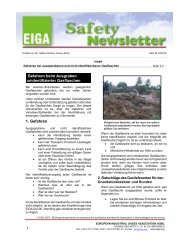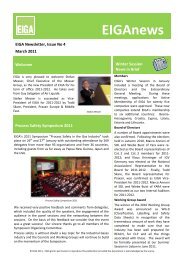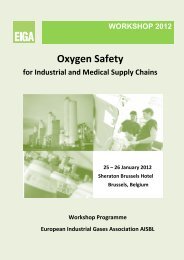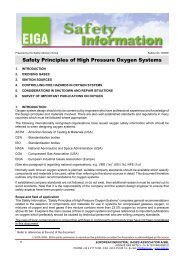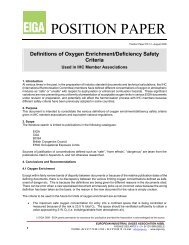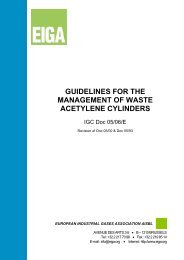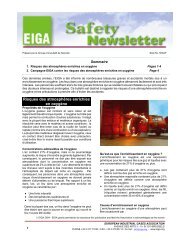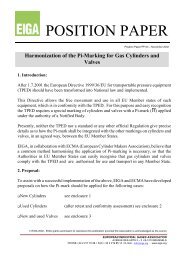CODE OF PRACTICE DRY ICE - eiga
CODE OF PRACTICE DRY ICE - eiga
CODE OF PRACTICE DRY ICE - eiga
You also want an ePaper? Increase the reach of your titles
YUMPU automatically turns print PDFs into web optimized ePapers that Google loves.
IGC DOC 150/08<br />
• Staff and visitor welfare arrangements (availability of separate eating, drinking, rest, smoking<br />
restrictions, toilets, washing facilities and the provision of anti-bacterial soap).<br />
• Pest control arrangements (for rodents, birds and insects). Insect contamination can be controlled<br />
by installing fly screen, UV light "zappers" or other equipment.<br />
• Waste management procedures (from welfare facilities, production operations, PPE renewal,<br />
container cleaning etc).<br />
• Register of acceptable engineering materials permitted for operational use (food safe lubricants,<br />
glass and plastic, conveyor surface and other contact materials, etc).<br />
• Use of metal detectors based on risk analysis.<br />
Management<br />
• Set of food safety risk management policies covering personal hygiene, jewelry, hair, use of<br />
plastic, wood, glass etc. It is recommended that the policies should be sensitive to the application<br />
and not attempt to create a fully compliant “ food factory “ regime.<br />
• Food safety to be considered when planning engineering tasks, modifications or maintenance via<br />
a permit-to-work system.<br />
• Suitable procedures to ensure the correct use, renewal frequency, type and specification of<br />
personal protective equipment (PPE). Overalls should be food type with no external pockets and<br />
with a routine laundering regime. Gloves; in order to offer effective thermal and mechanical<br />
protection it is not likely that gloves will be food safe, therefore an effective regime of renewal and<br />
specification of clean job gloves and dirty job gloves will be required.<br />
• Routine plant inspections and audits of the management / operating system.<br />
Safety: CO2 monitoring system<br />
There must be a system in place to ensure that OEL levels are correctly monitored. The work area<br />
shall be equipped with continuous CO2 monitoring and, if necessary, the staff shall carry a personal<br />
monitoring device.<br />
8 Production equipment requirements<br />
Note: The following apply specifically to food applications. For non-food applications there are no<br />
specific requirements.<br />
8.1 Storage vessels for liquid CO2<br />
Materials of construction shall be compatible with the dry ice manufacturing process and shall not<br />
introduce contaminants that would present a risk to food safety.<br />
Formalised systems should be in place to ensure that when storage vessels are transferred from one<br />
service to another, or new storage vessels are installed, product quality is assured and / or<br />
maintained.<br />
Prior to first filling, storage vessels and liquid distribution piping system should be sufficiently purged<br />
by CO2 until the correct quality is obtained.<br />
8.2 Recovery plant<br />
The CO2 recovery system shall not introduce contaminants that would present a risk to food safety.<br />
8.3 Production, handling and packaging equipment<br />
The design and construction of extruders, presses, chutes, conveyors, saws, packaging and other<br />
equipment used for the production of dry ice should minimise the opportunity for contamination that<br />
would produce a risk to food safety. Their condition should be guaranteed by regular inspection.<br />
6



